
 |
|
|
|
|
|
Devonian Black
Shales Eastern US |
|
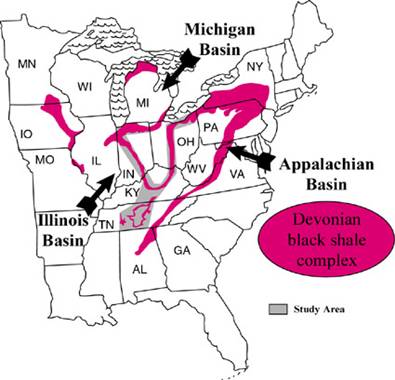 The
Mid-Late Devonian black shales of the Appalachian, Illinois, and
Michigan Basins have long been studied to provide clues to past
climates, ocean ventilation, mass extinctions, and general earth
history. Common misconceptions about these shales are that they
represent distal deposits that accumulated in deep waters of
stratified anoxic basins, and that they form a largely continuous,
though condensed, succession. We have shown that these shales
contain numerous discontinuities, and represent at least in part
shallow water deposition. Truly anoxic conditions must have been
exceedingly rare occurences. The
Mid-Late Devonian black shales of the Appalachian, Illinois, and
Michigan Basins have long been studied to provide clues to past
climates, ocean ventilation, mass extinctions, and general earth
history. Common misconceptions about these shales are that they
represent distal deposits that accumulated in deep waters of
stratified anoxic basins, and that they form a largely continuous,
though condensed, succession. We have shown that these shales
contain numerous discontinuities, and represent at least in part
shallow water deposition. Truly anoxic conditions must have been
exceedingly rare occurences. |
|
| Large scale erosion surfaces,
traceable over large distances, partition the Devonian black shale
succession into successively deposited packages. These erosion surfaces reflect intermittent sea level drops followed by transgression and renewed black shale deposition. They are the basis for a coherent sequence stratigraphic framework for all of these shales. |
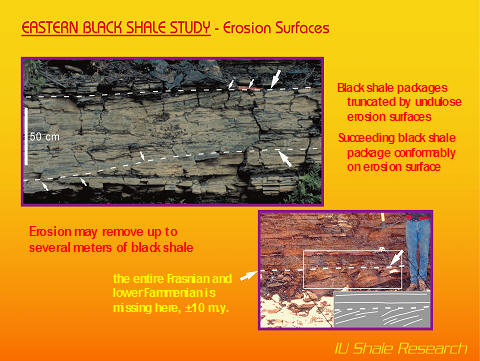 |
| Erosion can be documented (and is common) at any scale, from sub-mm scours, over removal of cm-scale shale beds (see picture), local truncations at the dm-scale, to deep m-scale erosion that is traceable for 100's of kilometers. |
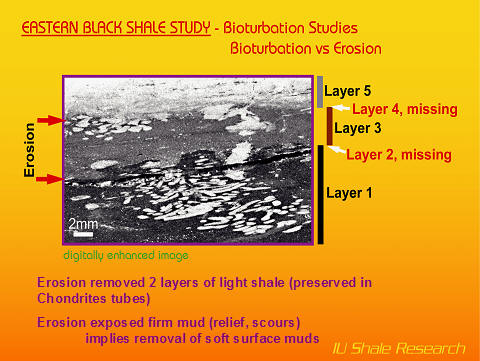 |
|
References for above: Schieber, J., 1994,
Evidence for episodic high energy events and shallow water
deposition in the Chattanooga Shale, Devonian, central Tennessee,
U.S.A. Sedimentary Geology, v. 93, p. 193-208.
download
PDF file (left click on link and click on "Save as"...)
|
|
| Aside of erosive features (above) shallow water conditions (10's of meters to 50 meters) are also indicated by storm deposits, such as HCS sandstones/siltstones, and coarse grained lags. |
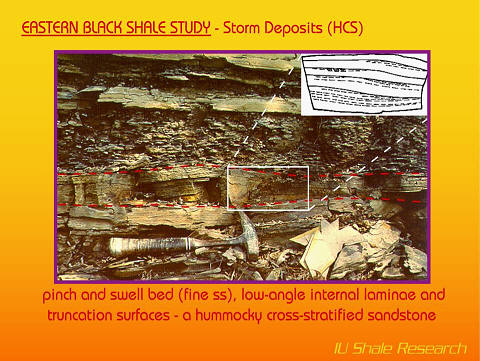 |
| Fine grained storm indicators are graded silt/mud couplets, graded rhythmites (at right), and mud tempestites. The latter are rapidly deposited mud-blankets that "smother" bioturbated horizons (at right). |
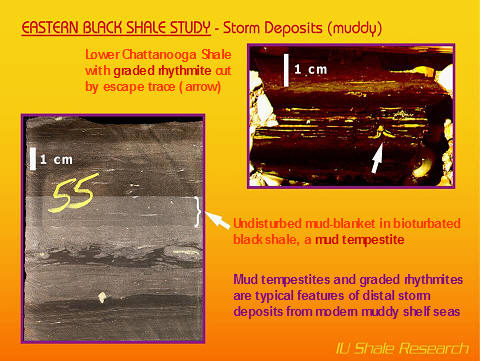 |
|
References for above: Schieber, J., 1994,
Paleoflow patterns and macroscopic sedimentary features in the Late
Devonian Chattanooga Shale of Tennessee: Differences between the
Appalachian Basin and the American Craton. Canadian Society of
Petroleum Geologists, Memoir 17, p. 763-772.
download PDF file
(left click on link and click on "Save as"...)
|
|
| Bioturbation is widespread and pervasive, but often missed because it is typically subtle and requires careful study of ground and polished surfaces. Digital image processing and X-radiography has revealed bioturbation in many shale intervals that were once thought of as unbioturbated. |
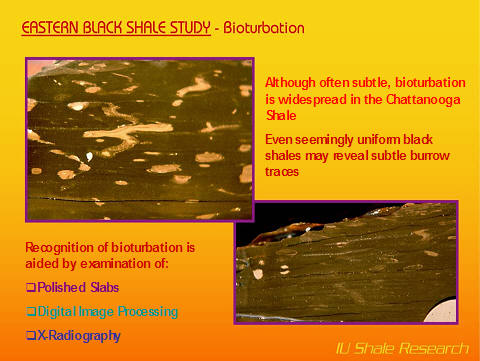 |
|
References for above: Lobza, V., and Schieber, J., 1999,
Biogenic sedimentary structures produced by worms in soupy, soft
muds: Observations from the Chattanooga Shale (Upper Devonian) and
experiments. Journal of Sedimentary Research, v. 69, p.
1041-1049.
download
PDF file (left click on link and click on "Save as"...)
|
|
| Pyrite ooids were discovered in lag deposits overlying major erosion surfaces. Subsequent study showed them to have originated as chamosite ooids during low-stands of sea-level. During sea-level rise the lag deposits were draped by black shales and the chamosite was replaced by pyrite. |
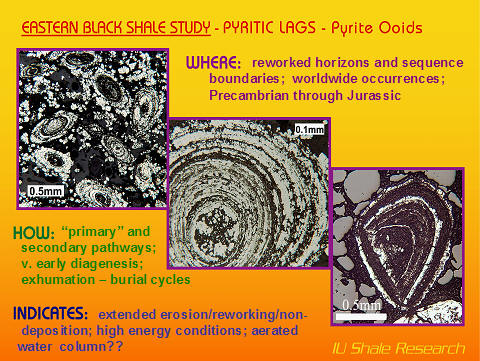 |
|
Pertinent References: Schieber, J., and Riciputi, L., 2004, Pyrite ooids in Devonian Black Shales record intermittent Sea level drop and shallow water conditions. Geology, v. 32, p. 305-308. download PDF file (left click on link and click on "Save as"...) |
|
| Early diagenetic pyrite infill of Tasmanites cysts produced spherical pyrite grains within slowly deposited black shales. Upon reworking and erosion these pyrite spheres were concentrated into pyritic lags that indicate high energy conditions via cross-lamination and scouring. |
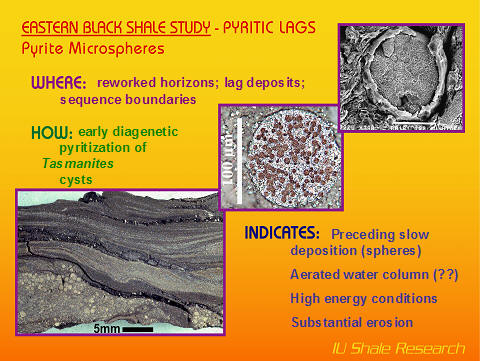 |
|
Reference for above: Schieber, J., and Baird, G., 2001, On the origin and significance of pyrite spheres in Devonian black shales of North America. Journal of Sedimentary Research, v. 71, p. 155-166. download PDF file (left click on link and click on "Save as"...) |
|
| Detailed petrographic investigations of quartz grains in these shales showed an appreciable proportion of authigenic quartz grains. The silica was derived from dissolving radiolarians and reprecipitated in pores, especially the cysts of Tasmanites. In places 80% or more of the visible quartz is of authigenic origin. This quartz can be detected easily with scanned cathodo-luminescence, and its authigenic origin was further confirmed through ion probe determination of oxygen isotope ratios. |
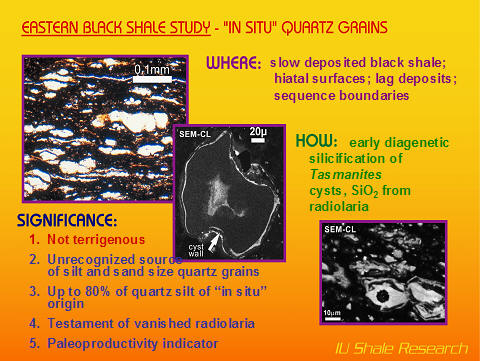 |
|
References for above: Schieber, J., 1996.
Early diagenetic silica deposition in algal cysts and spores: A
source of sand in black shales? Journal of Sedimentary Research,
v. 66, p. 175-183.
download PDF file
(left click on link and click on "Save as"...)
|
|
| Continued study of petrographic and geochemical features of these black shales provides us with an ever more detailed understanding of their depositional setting. Work in progress is an examination of geochemical anoxia proxies to assess their reliability (or rather the lack thereof), an in depth examination of framboid diameter distributions, and experimental work on the formation of black shale rhythmites. Stay tuned. | |
|
|
|
| Back to SHALE RESEARCH LAB Main Page | |
| Back to IU Department of Geological Sciences | |
|
© Jürgen Schieber, IU Bloomington Department of
Geosciences Last updated: November 04, 2023. |
|